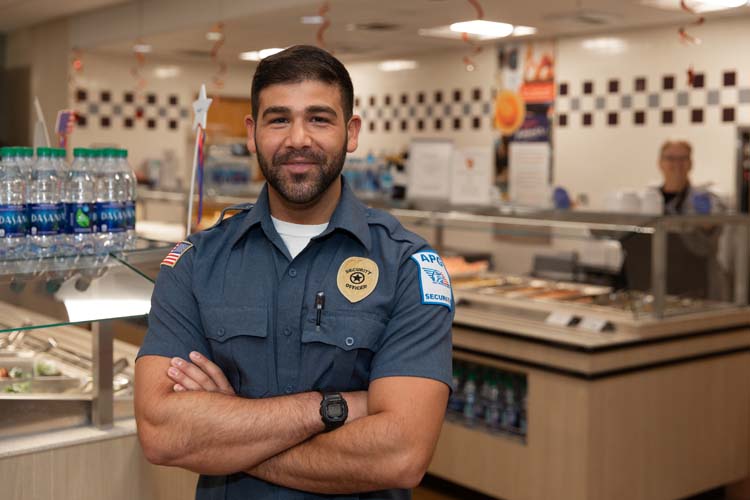Hospital security guards are often described in online ads as “someone who does not provide treatment to patients, but is a very visible hospital employee, often greeting patients when they enter the facility. Their main duty is to protect people, property and information as well as the hospital’s reputation.”
Sebastian River Medical Center security guard Matt Ferraro more than lives up to that description, especially the part about protecting people.
In the span of less than a month, Ferraro hopped onto a moving truck to prevent a medically impaired driver from running over two nurses in the parking lot and, a few weeks later, leapt into action in a hospital break room to prevent an emergency room nurse from choking to death, using training he paid for out of his own pocket.
“Patient and staff safety are our No. 1 priority at Sebastian River Medical Center,” says hospital president Kelly Enriquez. “On two separate occasions, Matt’s expert skills and quick responsiveness saved lives. We are appreciative to have him on our team.”
Like most emergencies, the choking incident came when it was least expected.
“I went into the break room to use the bathroom,” Ferraro recalls. “While I was washing my hands, I heard a nurse in the next room say, ‘Oh my God’ and then kind of just a coughing – almost like a gargling sound.
“I thought maybe she was talking on the phone at first, or something. Maybe arguing or joking with somebody and laughing. But when I walked out, she was all red in the face and pushing things all over the place. There was coffee all over the floor and on her shirt. She had tried to flush whatever it was that was lodged in her throat, but because it blocked it, all the coffee just came out of her mouth.
“She was really, really red and panicking, so for a second I thought maybe I should get a paramedic from the emergency room but then I remembered that I was BLS (basic life support) certified so I figured I would just do it and get a paramedic after.”
It was a good decision.
“I made sure I got one proper thrust and I managed to dislodge it. It didn’t come out but it did dislodge and she was able to swallow whatever it was she was choking on. And she looked up and said, ‘I’m OK.’”
Discretion being the better part of valor, Ferraro immediately set off to get one of the hospital’s paramedics to come check out the now not-choking ER nurse.
Almost blushing, Ferraro adds, “I was afraid that maybe I hurt her, or if what I did didn’t work, so but apparently it did.”
Ferraro was able to help the nurse because he had taken a Basic Lifesaving Course before being hired by the hospital. According to the American Heart Association, the BLS course “trains people to promptly recognize life-threatening emergencies and give high-quality chest compressions,” like cardiopulmonary resuscitation (CPR) and the Heimlich maneuver.
Ferraro, it seems, was a good student.
“I actually paid for that [course] before I came here,” Ferraro explains. “The job actually didn’t require that but I got it on my own accord. It was a $35 investment that paid off.”
A few weeks earlier, this young native New Yorker had to take on what may have been an even scarier task in the hospital parking lot.
“A man almost backed over two people,” says Ferraro, “and I had to jump in his car and stop him from backing over them and leaving.
“It was a man who was leaving under the influence AMA (against medical advice),” Ferraro explains. “We were trying to find him a ride and I guess he was reluctant to wait. But he was really stumbling on his way out so I followed him. He fell on the way to his truck and then he got back to his feet.
“So I’m just following him to make sure he doesn’t get in his truck, but he does, and then starts it. And then I hear one of the nurse supervisors say, ‘Get his keys.’ [But] he backs out really fast.”
At the same time, two people were walking across the lot, in the path of the impaired man’s vehicle.
“I jumped on the step of his truck and cut the wheel and hit the brakes and took his keys,” Ferraro says.
That was another good decision, according to Jason Redding, the hospital’s director of emergency services. “Matt took immediate and decisive actions to prevent an intoxicated person from running over an elderly pedestrian and a staff member,” says Redding.
“Matt was able to detain the driver until police arrival. The pedestrian credited Matt’s actions with saving her from being hit by the vehicle.”
That’s a good deal more than just greeting patients, protecting property and being visible.

